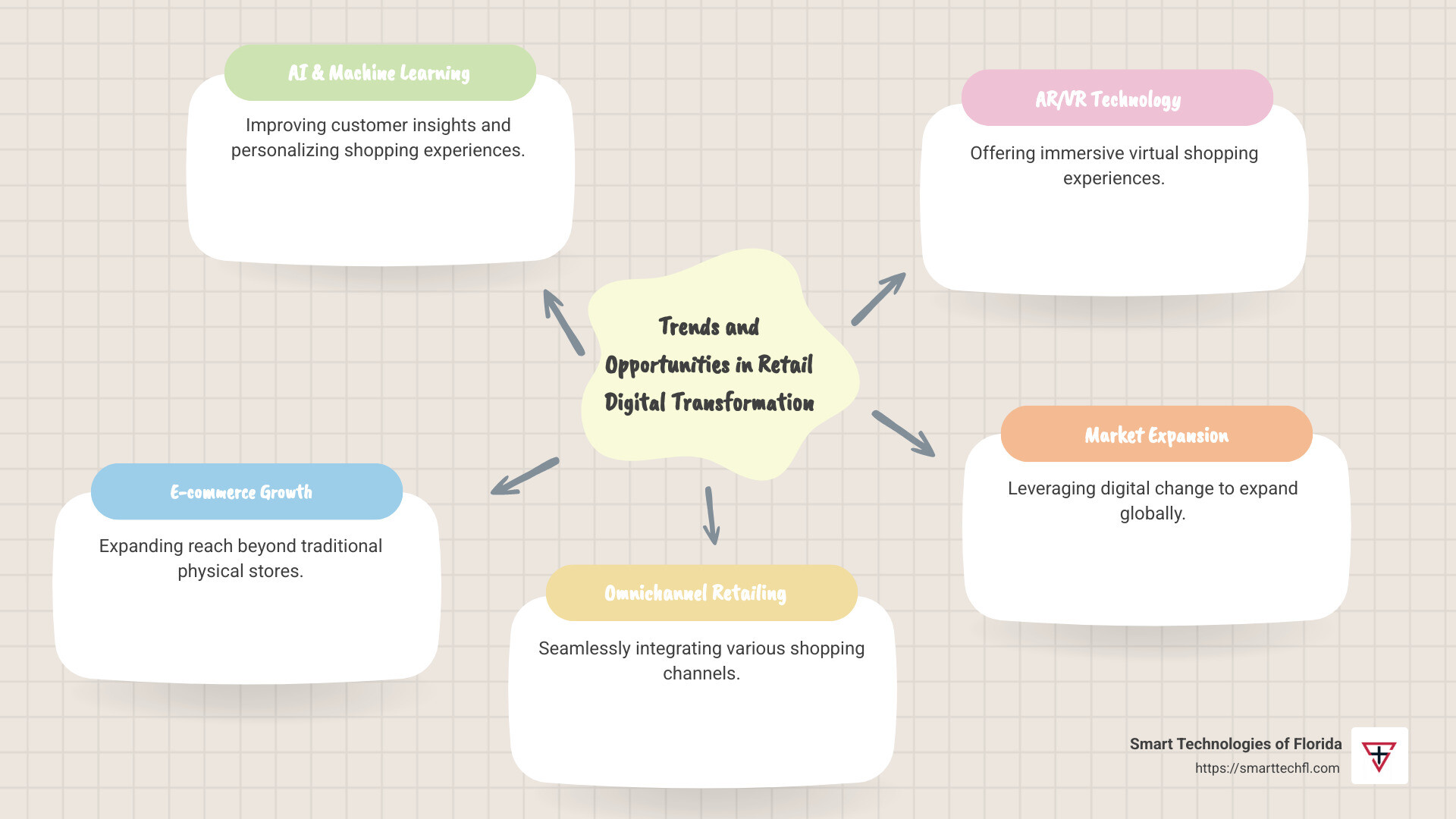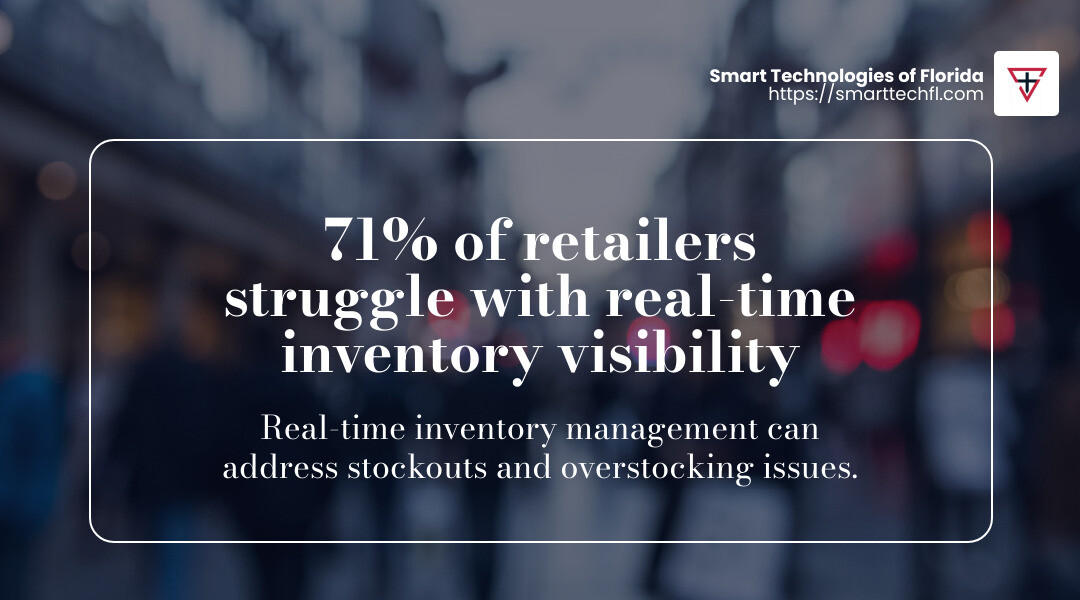Digital Transformation in Retail: Trends, Challenges, and Opportunities
Trends and opportunities for retail digital change have emerged as essential components driving the future of the retail industry. Today, retail businesses are facing the urgent necessity to digitally transform in order to stay competitive and meet changing customer expectations. Here is a quick glimpse into this change:
- AI and Machine Learning: Improve customer insights and personalize shopping experiences.
- E-commerce Growth: Expands a retailer’s reach beyond traditional physical stores.
- Omnichannel Retailing: Integrates various shopping channels for a seamless customer experience.
- AR/VR Technology: Offers immersive virtual shopping experiences like virtual try-ons.
In the evolving retail landscape, digital change isn’t just important—it’s unavoidable. As consumers become more tech-savvy, retailers must adapt by embracing innovative technologies that streamline operations and improve customer engagement. This shift is not merely about adopting new tools but changing mindsets to accept a digital-first approach.
Retailers who understand and implement these trends can find opportunities to personalize customer interactions, achieve operational efficiency, and potentially expand their market presence globally. The pressure is on for retail businesses to pivot and stay ahead, but the rewards of a successful digital change can redefine what success means in this industry.

Trends in Digital Change
AI and Machine Learning
In today’s retail world, AI and Machine Learning are game changers. These technologies are all about understanding customers better. By analyzing big data, retailers can predict trends and offer personalized shopping experiences. Imagine walking into a store and getting recommendations that seem tailor-made just for you. That’s AI at work.
AI doesn’t just help in-store. Online, it powers chatbots that answer questions 24/7, offering instant support. It also helps in optimizing pricing and inventory management by predicting what will sell and when. This means fewer “out of stock” moments and happier customers.
Omnichannel Retailing
Omnichannel Retailing is all about seamless shopping experiences. Customers today switch between online and offline shopping without thinking twice. They might see a product online, check it out in-store, and then buy it through a mobile app. This seamless integration is what omnichannel is all about.
Retailers need to ensure that their systems talk to each other. This means syncing inventory, pricing, and promotions across all platforms. The goal? Make the shopping experience as smooth and enjoyable as possible.
Home Depot, for example, offers a click-and-collect service, allowing customers to order online and pick up in-store. This kind of service not only boosts sales but also improves customer satisfaction.
AR/VR and the Metaverse
Step into the future with AR/VR. These technologies create immersive experiences that captivate customers. Imagine trying on clothes without stepping into a fitting room or placing furniture in your living room without lifting a finger. AR makes this possible.
Retailers like IKEA use AR to let customers visualize how furniture will look in their homes. Warby Parker offers virtual try-ons for glasses, reducing the need to send trial pairs to customers’ homes. These virtual try-ons not only save time but also improve the shopping experience.
As we look to the future, the Metaverse is on the horizon. It promises to create digital spaces where customers can shop, socialize, and explore like never before. Retailers who accept these technologies will not only attract tech-savvy customers but also redefine shopping itself.
These trends and opportunities for digital change in retail are reshaping the industry. Retailers who adapt to these changes can expect to thrive in a competitive market. The journey is challenging, but the potential rewards make it worthwhile.
Challenges in Retail Digital Change
The path to digital change in retail is not without its problems. Let’s explore some key challenges retailers face.
Legacy Systems
Many retail businesses rely on legacy systems that have been in place for years, sometimes decades. These systems can be difficult to update or integrate with new technologies. This can make it tough for retailers to adopt digital solutions quickly. Integration issues often arise, requiring businesses to find ways to connect old systems with new digital platforms.
Retraining staff is another significant challenge. Employees accustomed to traditional systems may find it hard to adapt to new technologies. Providing adequate training and support is crucial to ensure a smooth transition.
Data Security
With digital change comes the responsibility of handling vast amounts of data securely. Retailers must be vigilant about data security to protect customer information. Privacy concerns are top of mind for consumers, and any breach can lead to loss of trust and potential legal ramifications.
Compliance with data protection regulations is essential. Retailers need to ensure they adhere to laws like GDPR and CCPA, which govern how personal data is collected and used. Non-compliance can result in hefty fines and damage to a retailer’s reputation.
Change Management
Change management is a critical component of successful digital change. Retailers need to foster a culture that accepts change and innovation. This involves clear communication and involving employees in the change journey. Resistance to change is natural, but with the right approach, it can be managed effectively.
Budget Constraints
Investing in digital change can be expensive. Budget constraints are a reality, especially for small to medium-sized retailers. The cost of new technologies, along with training and potential disruptions to regular operations, can strain financial resources.
However, the long-term benefits of digital change often outweigh the initial costs. By prioritizing investments and seeking cost-effective solutions, retailers can steer these financial challenges.
Adoption Challenges
Finally, adoption challenges can slow down digital change. It’s not just about implementing new technologies but ensuring they are used effectively. Retailers may face resistance from employees who are hesitant to adopt new tools and processes.
To overcome this, retailers should focus on user-friendly solutions and provide ongoing support and training. Encouraging feedback and making incremental changes can also help ease the transition.
These challenges are significant, but they are not impossible. By addressing them head-on, retailers can pave the way for successful digital change, leading to improved customer experiences and operational efficiency.
Opportunities for Digital Change in Retail
Digital change offers numerous opportunities for retail businesses to thrive in a competitive market. Let’s explore how retailers can leverage these opportunities.
Real-time Inventory Management
Real-time inventory management is a game-changer for retail. With advanced technologies, retailers can now track their stock levels accurately and in real-time. This allows for demand forecasting and stock optimization, ensuring that the right products are available at the right time.
In fact, 71% of retailers have identified “lack of real-time inventory visibility” as a significant obstacle. By adopting real-time management systems, retailers can not only meet consumer demands but also avoid losing sales due to stockouts or overstocking.

Mobile Commerce
Mobile commerce, or m-commerce, is rapidly growing. With the rise of mobile apps and improved ecommerce platforms, consumers can shop from anywhere at any time. This shift has led to significant ecommerce growth, providing retailers with new avenues to reach customers.
Retailers can improve customer engagement by offering personalized experiences through mobile apps. By analyzing customer data, businesses can tailor product recommendations and promotions, creating a more personalized shopping experience. This not only boosts sales but also fosters customer loyalty.
Customer Personalization
Personalization is a powerful tool in the retail arsenal. By leveraging customer data, retailers can create custom experiences that resonate with individual preferences. This can be achieved through personalized marketing campaigns, product recommendations, and special offers.
For example, AI-driven personalization can analyze browsing history and past purchases to suggest products that customers are likely to buy. This level of personalization improves the customer experience and encourages repeat business.
Operational Efficiency
Digital change streamlines operations, making them more efficient. By automating routine tasks and optimizing workflows, retailers can reduce operational costs and improve productivity. For instance, automating logistics and order processing can significantly cut down on manual labor and errors.
Retailers can also benefit from cloud computing, which offers scalable and cost-effective data management solutions. This enables better collaboration and access to real-time data, aiding in informed decision-making.
Global Expansion
With digital tools, retailers can expand their reach beyond local markets. Platforms like Shopify enable businesses to enter international markets effortlessly by handling currency conversion, language translation, and local payment methods.
A great example is WOLFpak, which saw a 528% increase in cross-border revenue after expanding internationally using digital platforms. This demonstrates the immense potential for retailers to grow their market share globally through digital change.
In summary, digital change presents a wealth of opportunities for retailers to improve customer experiences, improve operational efficiency, and expand globally. By embracing these opportunities, retailers can position themselves for success in the digital age.
Frequently Asked Questions about Digital Change in Retail
What is digital change in the retail industry?
Digital change in retail means rethinking how businesses operate and connect with customers. This involves using technology to improve customer interactions and streamline operations. Retailers are shifting from traditional models to digital-first approaches, making shopping more convenient and personalized.
For instance, many retailers now offer both online and in-store experiences, known as omnichannel retailing. This approach ensures that customers have a seamless shopping experience, whether they’re browsing online or visiting a store.
What are the benefits of digital change in retail?
Digital change brings numerous benefits to the retail industry. One of the most significant is improved customer experience. By using digital tools, retailers can offer personalized recommendations and faster services, making shopping more enjoyable.
Operational efficiency is another major benefit. Technologies like AI and machine learning help retailers analyze data to optimize processes, reduce costs, and improve decision-making. For example, digital tools can automate inventory management, reducing the risk of overstocking or stockouts.
Moreover, digital change increases customer engagement. With tools like mobile apps and personalized marketing, retailers can connect with customers on a more personal level, fostering loyalty and repeat business.
How can small retailers benefit from digital change?
Small retailers can significantly benefit from digital change. By adopting digital tools, they can improve their operational efficiency and compete with larger chains. For example, using ecommerce platforms allows small retailers to reach a broader audience beyond their local area.
Digital tools also enable small retailers to offer personalized experiences, which can set them apart from competitors. By analyzing customer data, they can tailor their offerings to meet specific customer needs, enhancing satisfaction and loyalty.
Additionally, digital change helps small retailers improve their customer reach. Through online marketing and social media, they can attract new customers and build a strong online presence. This broadens their market and increases sales potential.
In conclusion, digital change is changing the retail industry by reimagining business models and enhancing customer engagement. It offers benefits like improved customer experience and operational efficiency, and it provides small retailers with tools to expand their reach and compete effectively.
Conclusion
Digital change in retail is not just a trend—it’s a necessity. At Smart Technologies of Florida, we understand that the key to successful change lies in strategic change and a people-centric approach.
Our 23 years of experience have taught us that every business is unique. That’s why we prioritize aligning our digital solutions with your specific goals. Whether you’re looking to improve customer personalization, improve operational efficiency, or expand globally, we have the expertise to guide you.
Strategic change is about more than just adopting new technologies. It’s about rethinking how your business operates and how you engage with customers. Our team focuses on creating custom solutions that empower your business to thrive in the digital age.
Our people-centric approach ensures that your change journey is smooth and effective. We work closely with your team to ensure that everyone is on board and equipped to accept new technologies. This approach not only boosts adoption rates but also improves employee satisfaction and productivity.
Ready to take the next step in your digital change journey? Let Smart Technologies of Florida be your guide. Explore our business process automation solutions and find how we can help you succeed in the changing retail landscape.












